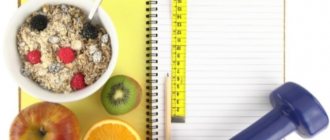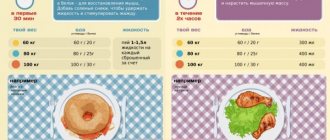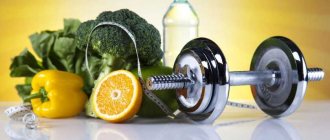Cardio training for weight loss: how to do it correctly?
Are you planning to run to lose those extra pounds? Be sure to read this article so that cardio training for weight loss does not become a disappointment.
No, running, of course, like other types of cardio training, plays an important role in losing weight, for example, burning calories. And if you follow the rules of rational nutrition, the result (in the form of lost kilograms) can be seen quite quickly.
However, the effect of them will not last long and the treasured number on the scales or measuring tape may not appear if you do not follow a simple rule: for effective weight loss you need a combination of a variety of physical activity and proper nutrition.
What is cardio training
Cardio training is a type of physical dynamic activity lasting 20–60 minutes with a relatively low intensity, aimed at strengthening the cardiovascular system and increasing endurance. This type of training is necessary to maintain physical fitness.
Conventionally, all physical exercises can be divided into aerobic (cardio) and anaerobic (strength). It must be emphasized that this division is very conditional. It is impossible to call any type of exercise aerobic or anaerobic in its pure form.
As with any other type of physical activity, before training you need to do a warm-up to warm up your muscles, and after it - a cool-down, several stretching exercises to relax them.
Cardio exercises include fast walking, climbing stairs, running, dancing, swimming, various types of games, aerobics, fitness, skiing, rowing, exercise equipment, etc.
An important condition when performing cardio exercises is to maintain a given heart rate throughout the entire workout.
The benefits of cardio training
During exercise, blood circulation increases and the heart pumps more blood per contraction, resulting in improved functioning of the cardiovascular system.
If such training is carried out regularly at the same intensity, the body gets used to it and endurance increases.
when doing exercises. If it’s hard for a beginner to train for 20 minutes, then for a trained person, fatigue from the load will come later.
During exercise, the body requires more oxygen, so lung capacity increases
, which also has a positive effect on endurance. Consequently, breathing will become deeper and more correct, which will help burn more calories.
Reduced anxiety and stress levels
: During training, the amount of endorphin, the hormone of joy, increases. And if you’re in a good mood and there’s no stress, then you don’t need to binge on anything.
Losing excess weight
, by burning subcutaneous fat, and
strengthening muscles
.
Rules for performing cardio training
- Before starting exercise, you should consult your doctor, especially if you have health problems or are overweight.
- The duration and intensity of the load must be increased gradually, then the body will not have time to get used to it and the weight loss process will not stop (plateau phase).
- Before training, be sure to warm up and stretch after. This will prepare you for the load and speed up recovery after it.
- During exercise, you need to monitor your heart rate using a heart rate monitor, for example. This is important, since a low heart rate will not bring results, and a high one can harm your health.
- Training should be fun. Feeling bad? Stop exercising.
Is it possible to eat during training?
In the gym, you can often see athletes drinking protein shakes from their own shakers during class. This nutrition option is only suitable for professional athletes during strength training, when they are preparing for performances and competitions.
During cardio training, you should not use protein drinks or bars, but you should definitely drink water.
On cardio equipment, you sweat a lot, and a water-salt imbalance occurs, which can lead to dehydration. During an hour-long workout, it is advisable to drink a liter of still water.
How to exercise to lose weight
Cardio exercises for weight loss are good because they can be done in the gym, on the street or at home, and they are suitable for both beginners and professional athletes.
The benefit of cardio training for many girls is achieving an ideal figure.
To lose weight, you need to do cardio 3-4 times a week for 30-45 minutes. Subcutaneous fat begins to burn only 20 minutes after the start of training, provided that the heart rate is maintained in the range of 60–80% of the maximum permissible heart rate.
subtract your age from 220 beats per minute;
multiply the resulting number by 0.6 - the lower norm; multiply the resulting number by 0.8 - the upper normal heart rate.
For example: 220-37=183;
183*0.6=109.8, rounded to 110 - this is the lower heart rate; 183 * 0.8 = 146.4, round according to the laws of mathematics and get 146 - this is the upper norm. It turns out that a person aged 37 years without any special health problems needs to train within these limits - 110–146 beats per minute.
The average heart rate during training is within 120–130 beats per minute.
The intensity of the exercises and the training time must be gradually increased, as the body gets used to the load and stops burning fat - a plateau effect. To speed up metabolism, it is very advisable to add anaerobic (strength) exercises to aerobic training, then the process of burning calories will continue after the workout.
Cardio exercises can be done at any time of the day: morning, afternoon or evening. It depends on your daily routine and personal preferences.
Cardio training is carried out in a well-ventilated room or outdoors, since oxygen is actively used during exercise.
How to Prepare for Cardio Exercise
Before training, check your heart rate limits. For the greatest accuracy in readings, you can even undergo a computer examination. This way you will know your maximum blood pressure during exercise. Another option for calculating the optimal heart rate is to use the formula: 220 – age. So, 65% of the obtained value is the lower limit of the pulse, and 85% is the upper limit.
Absolutely all modern exercise bikes and treadmills are equipped with special sensors for monitoring heart rate. To take the measurement, simply place your hands on the handrails while running on the treadmill. For the greatest accuracy in readings, use additional measuring sensors built into bracelets, watches and other devices.
Types of Cardio Training
The best type of cardio training for beginners and overweight people. To start losing weight, you need to walk quite quickly and for a long time, since the intensity of this exercise is low. Beginners should start by walking at a normal pace and gradually increase their speed. Or alternate walking at a fast pace with a normal step - interval loads.
You can exercise outdoors and in the gym. Probably the most popular type of training. This can be running on a machine, on the spot, interval running or jogging - it depends on your capabilities and preferences. There are restrictions: not suitable for overweight people, as this can result in serious injury. When running, it is important to monitor your pulse, breathing and well-being.
Dancing
- good because they are suitable for any person. Dance classes are a great option for girls who have recently given birth. You can do such cardio training in a group or individually, in the gym or at home.
Zumba is very popular - a fun and energetic workout that includes elements of different dances. During the lesson, the maximum number of muscles is worked out, including the abdominal and pelvic muscles.
Tested for myself: the training is quite intense, at first it is difficult to remember the movements. But the result is worth it - your mood improves immediately, your heart rate is suitable for burning fat. There are no restrictions for classes. You can dance in the hall or at home, fortunately it’s not difficult to find a video course. I’ve been training for two weeks, and there’s no result in the form of lost kilograms yet.
(treadmill, exercise bike, rowing machine, ellipse)
- It’s better to practice them with a trainer. It is easy to get injured when working on your own. In addition, the instructor will give recommendations and ensure that the workout is performed correctly.
Suitable for almost everyone. All muscles of the body are developed. Minimal load on the spine. To achieve your goal, you need to exercise 3-4 times a week for an hour.
Bike
helps strengthen the heart, leg muscles, and develop endurance. You can also exercise on the simulator. At the same time, the load on the knees is less than when running.
Rules for effective cardio
- Cardio training lasting 1 hour should take place 3-5 times a week.
- Depending on the choice of aerobic activity (cycling, running, swimming, jumping rope), be guided by your well-being and preferences.
- Do interval training 2 times a week.
- The sports program should include 2-3 strength training sessions.
- During exercise, maintain your heart rate at 65-70% of the upper limit.
- To prevent the weight from returning, do cardio at least 3-4 times a week.
- Combine exercises for the development of the cardiac system and weight loss. Moreover, in the first case, the training intensity should be at maximum (up to 85% of the upper heart rate limit), and the duration of the session should be no more than 20 minutes. In the second case, choose a moderate rhythm with a load of no more than 65% of the maximum heart rate.
What do cardio workouts give you?
The main thing that cardio training is for is that it is a great way to get in shape, improve your health, increase stamina, gain a good mood and self-confidence.
For exercise to bring results, choose a type of load that will make you enjoy the exercise. If running is too boring and monotonous for you, choose group classes in dancing, fitness, step aerobics and others. The good news is that aerobic exercise includes many types of exercise.
Don't forget about proper nutrition even when playing sports.
Take care of your well-being, a beautiful figure is good, but health is more important.
Performing cardio exercises saturates the body with oxygen, trains the cardiovascular system, and increases endurance.
and helps
active fat burning
.
Achieving such a result is possible by following an integrated approach, which is why training is combined with appropriate nutrition.
The quality and quantity of products plays a special role
consumed after doing cardio.
Nutrition rules after cardio training
- never fast
after intense physical activity.
Not eating for at least 2 hours
after exercise is a common myth in fashion magazines, which will not lead to accelerated weight loss, but to the appearance of a bad mood, weakness, dizziness and destruction of body muscles, which will negatively affect the overall tone of the body.
- You should not eat food immediately after a cardio workout in the wake of surging hunger
, as this can lead to overeating. - The best option is to consume protein foods 30-45 minutes
after finishing your workout. - After 1.5-2 hours,
or about
an hour
after eating protein foods, you can take a full meal, including complex carbohydrates. - If cardio exercises were carried out in the evening
, it is better to replace complex carbohydrates after training with a lighter option (for example, a vegetable salad with added protein).
For the first meal after 30-45 minutes
After completing a cardio workout, as already mentioned,
protein
products are suitable:
- egg white;
- protein
, in particular whey protein (fast digestibility); - dietary types of meat
:
veal; - chicken
(fillet, liver); - turkey meat
(fillet, liver);
Attention!
Protein foods
help improve the absorption of carbohydrates , so it is recommended to add
a steamed meat cutlet or eggs
(boiled or fried without oil) to the side dish.
If we are talking about nutrition after 1.5-2 hours
after completing cardio,
slow carbohydrates
with a low glycemic index are suitable (that is, they gradually release energy, their intake helps high-quality recovery):
- cereals
(buckwheat, barley, pearl barley); - porridge
(the ideal option is oatmeal; at the same time, avoid semolina); - rice
(best brown or basmati); - fresh or boiled vegetables
(optimally steamed); - pasta
(cooked with whole wheat flour).
Is it possible to eat immediately after training?
Contrary to popular belief about the need to fast after intense aerobic exercise to achieve better weight loss results
, you need to eat after training.
- During cardio exercises, the body works in a mode of increased heart rate
,
rapid breathing
, that is, it is in a state of stress. At this time, a lot of effort is spent, and energy reserves are depleted. The need to restore the body’s vital reserves is the main prerequisite for eating after exercise.
Photo 1. Table of changes in heart rate during training of different degrees of intensity
- Fasting after cardio can lead to sudden jumps in blood pressure
, and that is, to a deterioration in health, dizziness, nausea, and weakness.
In some cases, loss of consciousness
. - The body burns calories during
exercise and
for some time after (15-25 minutes)
.
For this reason, eating immediately after exercise is undesirable, as the desired fat burning occurs. But long-term fasting (3 hours or more) is also inappropriate. - Abstaining from consuming nutrients after cardio will contribute to the destruction of muscle cells
, due to which the body will try to restore energy reserves.
What is better and healthier to eat: examples of meals
After 30-45 minutes
After completing the training, the following options are most suitable:
- 2-3
boiled eggs (the yolk can be used as desired, but if the main goal is
weight loss
, then it is better to use
no more than one
); - omelet from 2 eggs and milk
(
fat content - up to 2.5%
, quantity -
100-200 ml
); - whey protein
(diluted
in 200-250 ml of milk with a fat content of up to 2.5% or water
if the main goal is weight loss); - boiled, baked with seasonings or fried without oil half of a chicken breast;
- cottage cheese (100-200 g)
with the addition of kefir, natural yogurt (ideal - Greek).
As for a full meal after 1.5-2 hours
, best suited:
- buckwheat porridge (40 g dry)
and steamed chicken cutlet with vegetables; - oatmeal (50 g dry flakes)
, prepared
with milk (fat content up to 2.5%)
or
water (150-200 ml)
and
70-100 g cottage cheese (fat content up to 5%)
; - whole grain flour pasta (40 g dry) and fried eggs
, fried without oil.
Athletes and people who spend time in the gym know that it is quite difficult to achieve the desired result through training alone. Therefore, along with the introduction of sports into life, it is necessary to reconsider nutrition and find out what it should be like before and after training.
How to eat before, during and after a run
Advice from professionals

From a medical point of view, such training is considered dangerous to health, as it provokes spikes in blood sugar and the reflux of bile into the stomach. On an empty stomach, you can only engage in calm sports - yoga, walking, stretching. There are several breakfast options that will not affect your figure and will give a boost of vivacity and energy to the body during exercise: unsweetened porridge with low-fat milk or water with the addition of berries, low-fat cottage cheese with sour cream and fruit, pancakes with cottage cheese made from cereal flour.
Bodybuilding trainer Irina Semenovich believes that nutrition during cardio training aimed at burning fat and reducing body fat should be different. In the first and second cases, it is important to consume protein, complex carbohydrates and fiber contained in fruits and vegetables, however, when gaining muscle mass, the amount of protein and carbohydrates consumed should be increased to 1-2 and 4-6 g per 1 kg of weight, respectively.
According to the trainer, reserves of organic compounds must be replenished both before and after training. Chicken or fish with vegetables, cereals, egg dishes, low-fat and lightly salted cheeses are allowed as a snack.
Nutrition before and after cardio training
Cardio training is a great way to say goodbye to extra pounds, which is subcutaneous fat, and tone your body. But, in order to achieve the desired weight loss, it is necessary to adjust your diet after cardio, as well as immediately before it.
Common types of cardio exercises that show good results in losing weight are aerobic exercise and running. Therefore, we can consider what nutrition should be like for weight loss, using aerobic training as an example.
The opinion of experts that one should not eat food before aerobic exercise turned out to be erroneous. In addition, it must be carried out in the first half of the day and performed immediately after waking up in the morning. Having reconsidered this statement, experts in the field of sports nutrition do not recommend training on an empty stomach. Therefore, if a workout lasting no more than 45 minutes is planned, then eating before it should be no later than 2 hours.
You need to eat before training
In order to charge the body with the energy it will need during cardio exercise, 2 hours before they start, you need to consume slow carbohydrate and protein, which is necessary for muscle formation.
A combination of protein and carbohydrate consumed before training will prevent insulin levels from rising in the body and promote effective fat burning.
During aerobic exercise, you should not limit your fluid intake. In this case, preference should be given to clean water. This is due to changes in the water-salt balance, which will need to be restored so as not to harm the body.
Be sure to drink water
At the end of aerobic training, the processes of breaking down fat deposits continue. This condition is short-lived. In addition, after cardio training, it is important to take food on time, in particular protein, the absence of which can lead to catabolism of muscle mass, which cannot be allowed in this case. Therefore, if you want to achieve effective weight loss, 30 minutes after completing the lesson you need to eat a product that contains fast protein. 30 - 40 minutes after fast protein is eaten, slow carbohydrate should enter the body.
You should not neglect meals before and after sports, because the result for which cardio training was chosen may be delayed.
30 minutes after completing the lesson, you need to eat a product with protein
When running, as in the case of aerobic exercise for weight loss, you need to eat right. You should avoid the idea of running in the morning on an empty stomach. The myths that this method will lead to weight loss many times faster have long been dispelled. On the contrary, such experiments on the body can have negative consequences.
Indeed, in order for the level of glucose in the blood to be within normal limits during a run, the presence of glycogen is necessary, which practically does not remain in the liver after a night’s sleep.
In order to provoke the breakdown of fat during running, before cardio training, you need to replenish the body with carbohydrates. But you should not overeat shortly before training, because this will not only make it difficult to perform the exercise, but can also affect digestion, causing a feeling of nausea and even vomiting.
Nutrition for weight loss before running should be limited to complex carbohydrates. The amount of food consumed directly depends on the time after which you plan to start running. If there is no more than an hour left before training, then consuming 100 calories of complex carbohydrates will be enough. For this amount of calories you can eat, for example, a banana or 30 grams of cereal.
If there are more than 3 hours left before your workout, in this case running, then your meal should be 300 calories. In this case, you can eat potatoes cooked in their skins, lean meat, such as chicken, and a slice of whole grain bread.
Some athletes make the common mistake of not eating after training. This may not lead to the most pleasant changes in the body, which should definitely be eliminated. Therefore, an hour after the end of the run, it is necessary to eat complex carbohydrates and protein, while protein should not exceed 8% of consumed carbohydrates.
You need to eat after a workout
Eating carbohydrate and protein foods after running to lose weight will contribute to the timely nutrition of muscle tissue, and will also lead to the body producing hormones responsible for anabolism within normal limits.
Having resorted to cardio training for weight loss, skipping meals after finishing it is undesirable. Unfortunately, not all athletes manage to eat a full meal after training, so you should always have a snack with you, for example, a fruit (banana, orange), with which you can still replenish the body with the carbohydrates it needs.
To achieve the desired result, you must follow the recommendations regarding nutrition before and after exercise. This is necessary in order to speed up metabolic processes in the body. In addition, more than half of your weight loss success depends on nutrition.
Created 11/09/2015
Eating before and after cardio is different than eating before and after strength training. What does cardio training include?
These are running, race walking, cycling, swimming and other activities that require continuous, prolonged movement and involve the heart in its work, increasing the heart rate. Eating well before and after exercise will greatly improve your cardio performance.
High Energy Foods
The body needs carbohydrates. After intense cardio training, you need to include carbohydrates in your menu to replenish your energy reserves.
Not all carbohydrates are created equal. Choose cereals, fruits, vegetables. They are rich in nutrients. But candies and sweets are empty calories, it’s better to avoid them.
I would like to draw your attention to dairy products and legumes. They contain carbohydrates and proteins that help in muscle recovery. The best carbohydrates to choose are those that contain a range of nutrients (protein, vitamins, fiber and antioxidants).
“A great start to the year”: actor Devon Murray from “Harry Potter” became a father
A selection of new foreign TV series to watch during the holidays
Wisconsin under investigation after 500 doses of COVID vaccine were spoiled
What are the benefits of cardio training?
Aerobics can do more than just help you lose weight. It is good for cardiovascular health. The number of cardio workouts can be from one to five per week. It depends on the goal, initial data and level of training.
You should always start with a minimum, increasing the duration of the load gradually. This is due to rapid adaptation to aerobic exercise. If your goal is to lose weight and improve your health, then the load should gradually increase. Gradually, you need to stop doing cardio, as well as increase calories after a diet.
Nutrition before cardio training
It used to be that it was ideal to do cardio in the morning before breakfast, since after an overnight fast the body begins to use fat more actively. Modern research shows that fat burning will increase if you take amino acids before training. These can be amino acid tablets or fast-digesting, high-nutrient protein products such as whey protein or egg whites. 10-20g of isolate or a couple of egg whites before morning cardio will be enough.

But this option is suitable for people who have a relatively low percentage of subcutaneous fat.
For those who have an average or higher body fat percentage, the time of training does not matter, the main thing is that they occur at all. If the cardio duration is 30-45 minutes, then it is optimal to eat 2-3 hours before training. It is better to choose protein and slow carbohydrates with a low glycemic index, which will curb insulin levels, provide sufficient energy before training and allow you to burn more calories from fat. 2-3 hours after your standard lunch, you can safely do cardio.
What to include on the menu
I offer an approximate list of products that are useful for those who prefer cardio exercise. They can be combined, and below we will look at how.
1. Protein source:
- yogurt, kefir;
- cottage cheese;
- egg white omelette;
- boiled (baked) veal;
- chicken (breast);
- fish;
- mushrooms;
- legumes
2. Slow carbohydrates:
- porridge (except semolina and polished rice);
- wholemeal bread;
- berries, not too sweet fruits (except grapes, bananas);
- pasta made from durum wheat or rice flour.
Nutrition after cardio training
During cardio, the body burns calories intensely. This process continues for a very short time even after training. Therefore, it is not recommended to eat immediately after cardio.
Some recommend abstaining from food for two hours, others - 45 minutes. Cardio training is a direct path to muscle catabolism, as is fasting after it. Destruction of muscles will not be beneficial at all for weight loss, since they are the main factor in metabolism. Therefore, it’s not worth waiting the whole 2 hours.
After cardio, 30-45 minutes later, consume a quick protein (whey protein or egg white). After another 45 minutes - slow carbohydrates. Or you can take protein immediately after cardio, and carbohydrates an hour and a half later.
Let's summarize:
Before the morning
cardio training, do not eat or take amino acids 3-6 g, drink whey protein 10-20 g or eat 2-3 egg whites.
Before daytime or evening
eat aerobically 2-3 hours before (last meal: slow carbohydrates + protein).
During training
drink water.
After cardio training
(immediately or after 30-45 minutes) drink whey protein or eat a few egg whites.
An hour and a half after
aerobics eat slow carbohydrates.
There are a huge number of different ways to lose extra pounds and improve muscle tone in the body. Some people choose strict diets and daily calorie counting, while others choose physical activity, which forces the body to intensively burn calories. The most common methods include losing weight through cardio training. What kind of exercises are these and what diet goes with them?
Main conclusions

When correcting weight, it is necessary to avoid consuming fast carbohydrates (sweets, baked goods, chocolate) before and after training. Light organic compounds are allowed to be consumed only during high-intensity exercise. Nutritionists do not recommend intensive training on an empty stomach, as it can negatively affect your well-being and health. “Hungry cardio” is only permissible during low-intensity exercise (during yoga or walking). Read more about this in the articles:
When working with weights, it is recommended to increase the daily dose of proteins and carbohydrates eaten to 1-2 g/kg and 4-6 g/kg, respectively.
Indications for use and features of cardio exercises
Cardio training is a set of exercises performed for a long time without stopping. In modern literature, this method of losing weight is often compared to aerobics and gymnastics. But the significant difference is that cardio uses energy that is obtained through the oxidation of glucose molecules with oxygen.
Typical examples of exercises for weight loss include running, exercise on an exercise bike, race walking, and swimming. Cardio exercises are recommended for people at risk for cardiovascular diseases.
The main advantages of the popular fitness trend:
- improvement of immunity;
- burning excess fat;
- strengthening the heart, blood vessels, veins and arteries;
- smooth weight loss.
It is very important that the frequency and duration of classes be approved by your doctor or an experienced trainer. Often, overloading the body causes a reverse reaction (the body begins to accumulate fat). At the initial stage, 2-3 sessions per week for 20-60 minutes are considered optimal.
Diet before and after sports activities
If performing exercises is aimed at normalizing body weight, then such a complex must necessarily include a change in diet. The golden rule of weight loss, which states that you need to burn more calories than you consume, is true in this case as well. Let's consider menu options for intense loads.
Nutrition before cardio training for weight loss
It has long been believed that the optimal time to start classes is early in the morning. This assumption was based on the fact that the body had used up all its energy reserves overnight, and physical activity would force it to burn unnecessary fat.
Practical observations have shown that this is not entirely true. Studies conducted by various medical institutes have documented the fact that cardio is much more effective if you eat foods with a low glycemic index (slow carbohydrates) 2-3 hours before it.
People with low levels of subcutaneous fat are allowed to limit their breakfast to egg whites, tableted amino acids or a special energy shake (whey protein).
Water-salt balance during sports
On some forums, the theory is actively discussed that limiting drinking during intense exercise significantly accelerates the loss of kilograms. This is a very dangerous misconception. What comes out with sweat is liquid, not fat. In this way, our body is protected from overheating.
All trainers and nutritionists insist that staying hydrated is of utmost importance. You need to drink a lot, otherwise by overloading your body, you will provoke pathologies of the heart and blood vessels.
Diet after exercise
Nutrition after cardio training for weight loss is based on preventing muscle catabolism. Many experts advise refraining from eating for two to three hours, but it would be better to have a snack with low-fat protein food (cottage cheese, yogurt, boiled egg) 30-45 minutes after exercise.
Eating restrictions after cardio concern slow carbohydrates. It is not recommended to overload the digestive system with pasta, bread, beans, beans, and peas.
Food before exercise

The substance is obtained from food or special medicines. The main meal is taken 2 hours before classes, provided that they last no more than 30 minutes. Also, before this, it is necessary to include complex carbohydrates in the diet, which will maintain the body’s energy reserves at the required level.











